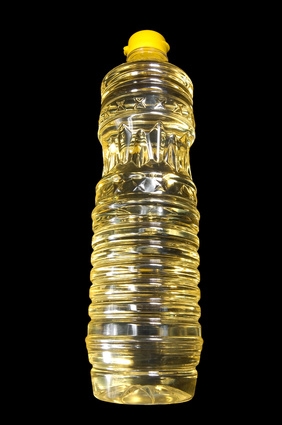
Many Americans are aware that diesel-powered vehicles get better gas mileage, but still believe the old stereotypes about diesel vehicles being dirty and sluggish. They are not perceived as the future for green technology the way that hybrids are. However, when Rudolph Diesel invented the diesel engine, it was with the intention that they would be run on vegetable and plant oil. In fact, that is exactly what most diesel vehicles used until the petroleum industry realized that they could market their leftovers from the gasoline refining process for use in diesel vehicles during the 1920s. Today's diesels have the ability to run on biodiesel, a fuel made from refined vegetable, oil which can be refined at home.
Measure KOH into a sealable plastic bag, being sure to work quickly so water does not get absorbed. If it is 92 percent pure, use 5.3 grams; 4.9 grams if it is 99 percent pure.
Pour 200 milliliters of methanol into one of the half liter containers using the funnel. Add the lye slowly and cap the mixture. Swirl in around to mix it, for about 10 minutes--be sure everything is dissolved and it is mixed completely.
Heat the oil to 130 degrees Fahrenheit and place it into a clean blender. Carefully add the methanol mixture (methoxide) to the blender. Turn it on low speed and mix for about 30 minutes.
Pour the mixture into a 2-liter bottle, screw the lid on tight and let it sit. The mixture will settle after about 24 hours. The result will be a lighter, paler liquid on top and a heavier, darker liquid on the bottom.
Pour the top layer into a separate 2-liter bottle--this is the biodiesel. If you get some of the darker liquid, which is glycerine, into the clean bottle, allow it to settle into layers again and pour the biodeisel layer into a new clean bottle.
Test the batch for quality using the wash test or methanol methods.
Add 25 milliliters of biodiesel to 225 millileters of methanol for methanol testing. It should dissolve completely. If there is any residue, then you need to adjust the processing.
Mix an equal amount of biodeisel and water to wash test. Shake briskly. Within a few minutes, your sample should settle out into two clear layers. This means it is clean.
Wash the rest of the biodiesel once it passes the tests. Take a 2-liter bottle with a hole in the bottom that has been taped over. Put a half liter of water in it and add the biodeisel.
Cap the bottle and roll it on its side to mix the water and fuel. Place the bottle upright and allow the mixture to settle. After settling, remove the tape to drain the water from the bottle.
Repeat the washing process two or three times until the fuel is clear. It will be ready to use.